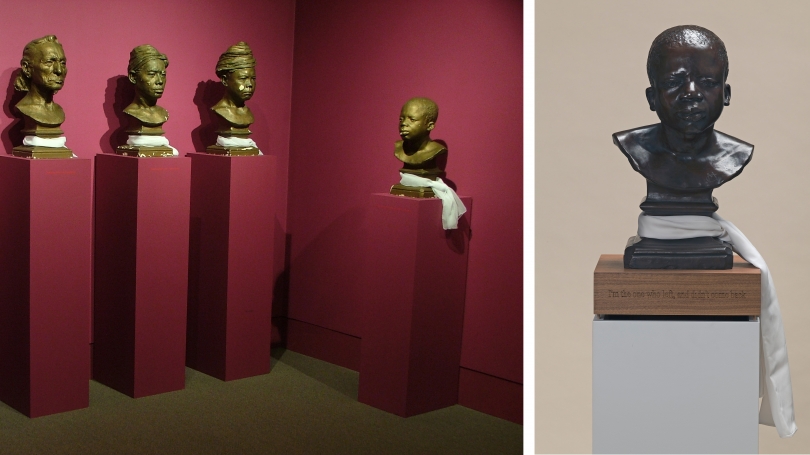Hood Quarterly, autumn 2015
Juliette Bianco, Interim Director
Ota Benga was a grossly mistreated and mostly neglected figure in the history of our country. He was taken prisoner in the Congo and transferred to the United States for display in the 1904 World’s Fair and then sent to live in the Bronx Zoo with the apes; he eventually committed suicide in 1916. One hundred years later, Fred Wilson discovered in the Hood Museum of Art’s storage a forgotten object that the museum had nevertheless chosen to hold in its care: a head sculpted using a life cast, labeled “pygmy.” Wilson dared to pull Ota Benga from the shelf and place him on a pedestal that brought his eyes to four feet four inches, the subject’s own height. The artist covered the hurtful label with a soft white scarf and restored dignity to the subject, and to the object. With that gesture, this artist made our museum a conduit for Ota Benga’s story.
That the Hood’s collection allows for the possibility of transformative moments such as that created by Fred Wilson is testament to the value of preserving works in the public trust over time—centuries, even—and it is a reason to recognize our ongoing commitment to this practice as the museum marks the thirtieth anniversary of the College’s art collections being housed under one roof. Just as Wilson’s 2005 Hood exhibition SO MUCH TROUBLE IN THE WORLD—Believe It or Not! shed new light on our purpose and practice as a teaching museum, it also inspired him to create a new work based on the subject, one that the Hood in turn acquired in 2012. That sculpture is now on view in the Hood’s lobby; please join us and artist Fred Wilson this coming February for a special panel discussion and film on the life and legacy of Ota Benga.
This fall, visitors to Collecting and Sharing: Trevor Fairbrother, John T. Kirk, and the Hood Museum of Art will learn about not only important new works in the collection but also the museum staff’s practice of mission-driven collecting, exhibiting, teaching, and publishing for the benefit of a wide community. We are grateful to Trevor and John for sharing our vision for the future of the museum, one that we have so fortunately celebrated with other great friends of the museum over the years. With the exhibition Canaletto’s Vedute Prints, as well, we acknowledge the legacy of Adolph J. “Bucks” Weil, Class of 1935, and the impact that his and his family’s remarkable gifts of Old Master prints have had, and will have, on generations of visitors. Finally, we are pleased to unveil this fall on the Maffei Arts Plaza an important new addition to our campus art collection, Hoarfrost with Rabbit [now titled Shelter] (2014) by Kiki Smith, acquired in recognition of forty years of coeducation at Dartmouth.
An anniversary is a moment to celebrate past achievements while actively working toward an even more promising future. As the Hood turns thirty, we are particularly excited to be rededicating ourselves to the museum’s mission through the College’s exciting expansion and renovation of the Hood building with architects Tod Williams and Billie Tsien. The finishing touches of the design development phase of the project will happen this fall, and we look forward to sharing renderings of what the new gallery, teaching, and lobby spaces may look like as we prepare for groundbreaking in mid-2016—look for this news, as well as information about how to stay connected to the museum while we are closed for construction, in the winter 2016 issue of the Hood Quarterly.
We look forward to seeing you at the Hood this fall and thanking you for your patronage and support!
In This Issue:
- Collecting and Sharing: Trevor Fairbrother, John T. Kirk, and the Hood Museum of Art
- Canaletto's Vedute Prints: An Exhibition in Honor of Adolph Weil Jr.
- Recent Acquisitions: Kiki Smith, Hoarfrost with Rabbit, 2014
- Recent Acquisitions: Attributed to William Hart, Tannery in the Catskills, about early 1850s
- Community of Learners: Autumn 2015
